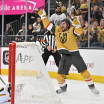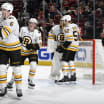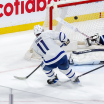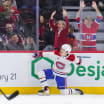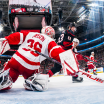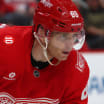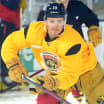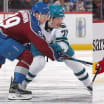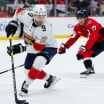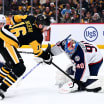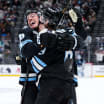Rutherford looking forward to joining his masks in Hall of Fame
Facial protection from bygone era brings back memories for goalie turned executive
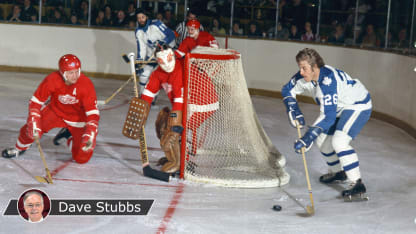
Among the 90 masks on display are two that were worn by Jim Rutherford, who on Monday will be enshrined as a builder in the Class of 2019.
Many stitches and a handful of teeth ago, the executive vice president of hockey operations and general manager of the Pittsburgh Penguins was an NHL goalie. He played 457 games between 1970-71 and 1982-83 for the Detroit Red Wings, Penguins, Toronto Maple Leafs and Los Angeles Kings.
Tack on another 174 games, counting Rutherford's time between the pipes in junior, the minor pro leagues and representing Canada in two world championships, and plenty more if you stir in his minor hockey career.
Rutherford's iconic Red Wings mask is joined in the Hall of Fame display by one he later wore with the Maple Leafs. Both bring back many memories for a former goalie who at age 70 still remembers how much a six-ounce disk of vulcanized rubber could hurt, especially through the shabby equipment of his day.
"I never had a mask that really protected me," Rutherford said Friday, having just placed his Hall of Fame ring on his finger in the shrine's historic Great Hall. "The first day I ever wore one, I was 16 or 17. I went to the twin rinks in Thornhill (Ontario) in late August to get ready to go to a training camp. I hadn't had my equipment on all summer. I went out, I'd say 30 or 60 seconds into it, a guy came down to the hashmarks, took a slap shot, hit me in the mouth and knocked out four teeth. Forty-some stitches. They didn't protect you that good."
Then, with a tight grin and a goalie's gallows humor: "But I guess if I didn't have the mask on, it could have been worse. It might have been five teeth."
Rutherford's Red Wings mask is part of hockey lore; it's the flashy work of legendary fiberglass mask maker Greg Harrison that was produced against the goalie's strong wishes. He chuckles about that now, pausing to study it behind glass in the Hall of Fame.
The dates and exact timing of its birth and debut are a bit fuzzy, but Rutherford remembers this:
On Jan. 17, 1974, he was traded by the Penguins to the Maple Leafs, and the deal didn't sit well. In transit, Rutherford met Harrison at the Toronto airport and told him to repaint his mask, covering the light blue of the Penguins with plain white, without frills.
"Like anybody, when you're traded, I was disappointed," Rutherford said of being moved by the Penguins. "I told Greg, 'I don't want it painted the red of the Red Wings. Just paint it white, understand?' He comes in to Maple Leaf Gardens for (the game-day) morning skate, a big smile on his face, takes the mask out of the box, and there it is: white, with wings over the eyes. I was very upset. But there was nothing I could do about it. [I was] playing that night. It was the talk of the broadcast, so I just kept wearing it."
Rutherford has undying respect for the barefaced goalies who went before him, especially his all-time favorite, the legendary Glenn Hall. "Mr. Goalie" played 502 consecutive games, 552 including the Stanley Cup Playoffs, without a mask for the Red Wings and Chicago Black Hawks between 1955-56 and 1962-63.
"People say they didn't shoot the puck as hard in those days," Rutherford said. "But even if I just threw a puck and hit you in the head right now, it would hurt you. It was amazing what those guys did. They were such brave guys, so determined. As a kid, I watched Jacques Plante, Johnny Bower, Glenn Hall. … Imagine a goalie playing more than 500 consecutive games without a mask. Absolutely amazing. Those guys were special people."
Plante famously wore a mask in an NHL game for the first time 60 years ago this month, his badly cut face protected when he skated back onto the ice at Madison Square Garden in New York with his Montreal Canadiens on Nov. 1, 1959. That historic mask, which forever changed the face of goaltending, is on separate display in the Hall of Fame.
Rutherford recalls his first boyhood visit to the Hall, when it was on the grounds of Toronto's Canadian National Exhibition.
"I can't remember how old I was, but my parents took me there and my mom took some pictures that day. I'll eventually find them," he said. "For the most part I'm a guy who lives today, not yesterday and what's going to happen tomorrow, so I haven't really reflected a lot on my playing career. Since it was announced (in June) that I was going to be inducted, I've taken more time to think about that, and it's really been an exciting part of my life."
Rutherford's two masks are joined by many wilder designs and the later-model helmet-and-cage combinations that would in many ways reflect the personalities of the men who wore them.
"I was at the start of goalies having a design on their masks," Rutherford said. "Lots of people come up to me and say, 'I remember when you played, I remember your Red Wings mask.' I walk away and think, 'Do they ever remember that I won a game or stopped any pucks? They only remember me by my mask.' But that winged mask is in the Hall of Fame, and a lot of people talk about it. That's nice to see."

